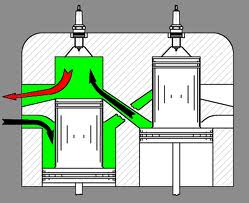The Two-Stroke Engine Cycle: Part Two
 Now that the first of the two strokes is complete, it’s time for the compression stroke. After the first stroke, the momentum created in the crankshaft propels the piston back to the spark plug. When the piston compresses the combination of air, gas and Yamalube 2S oil, it creates a vacuum which opens the reed valve and allow the mixture to be extricated from the carburetor.
Now that the first of the two strokes is complete, it’s time for the compression stroke. After the first stroke, the momentum created in the crankshaft propels the piston back to the spark plug. When the piston compresses the combination of air, gas and Yamalube 2S oil, it creates a vacuum which opens the reed valve and allow the mixture to be extricated from the carburetor.
Once the piston makes it through the combustion stroke, the cycle simply starts again. This combination of compression and combustion strokes explains the “two-stroke” portion of the engine’s name. Four-stroke engines have separate intake and exhaust cycles in addition to the combustion and compression strokes.

